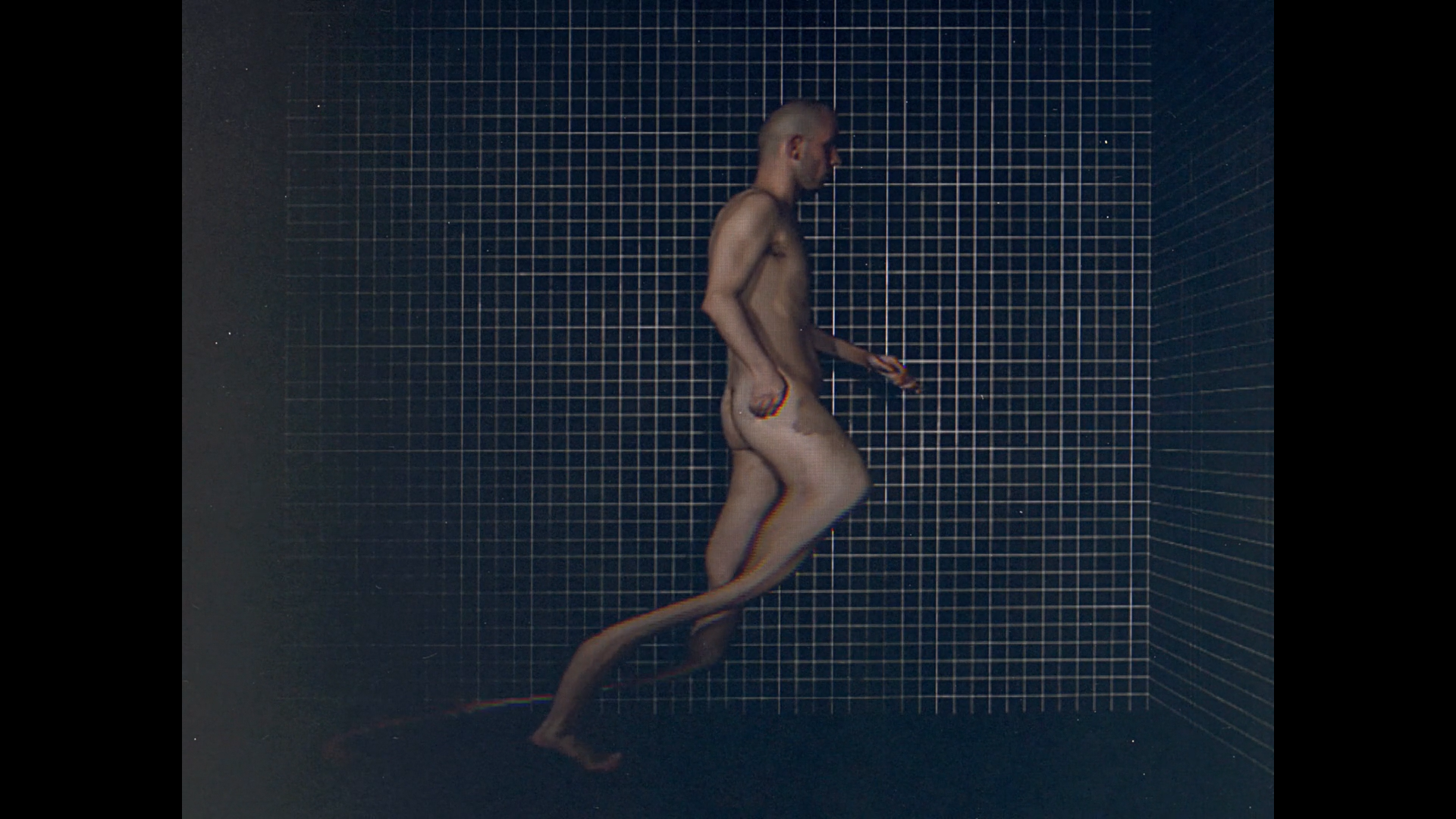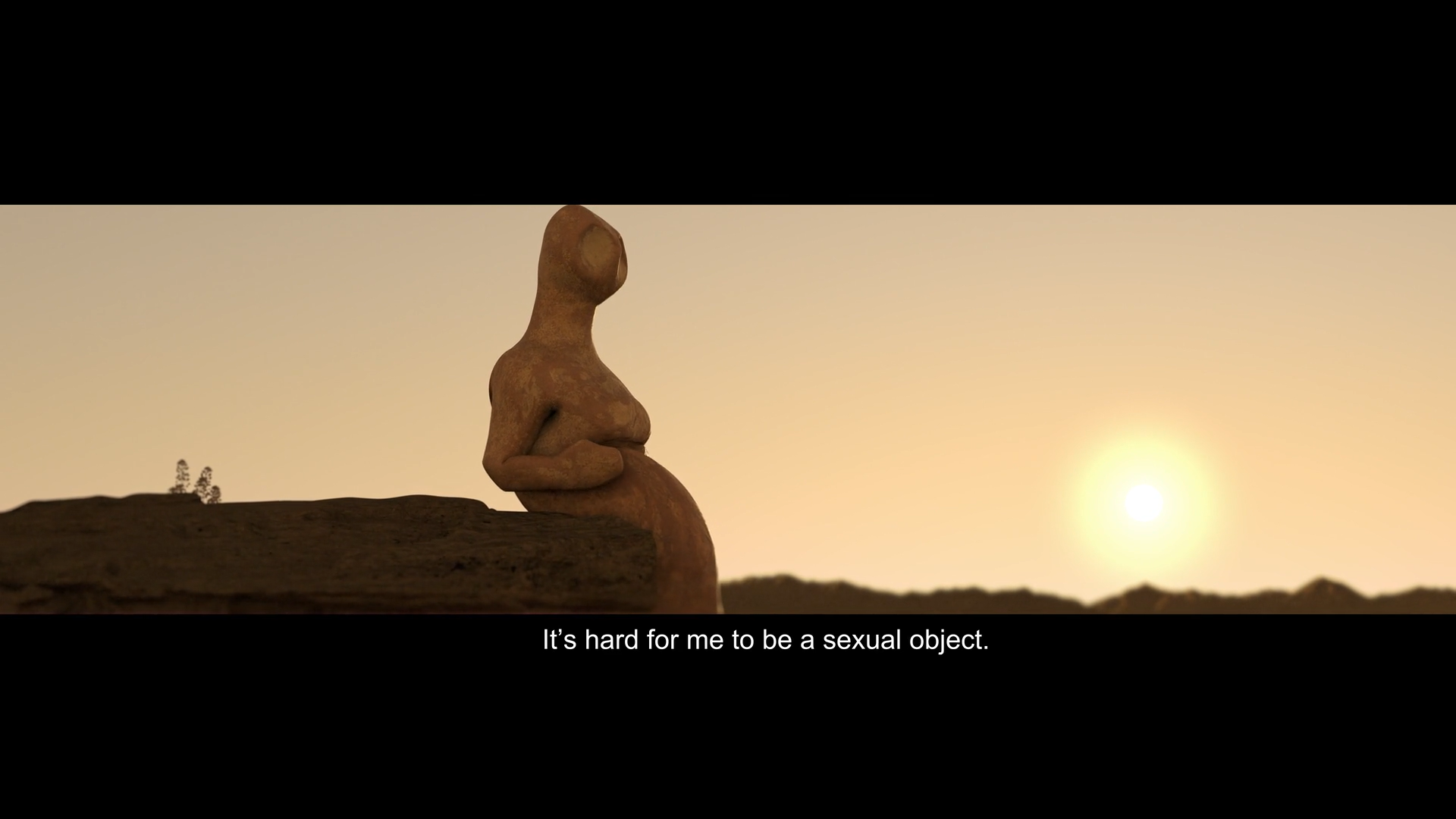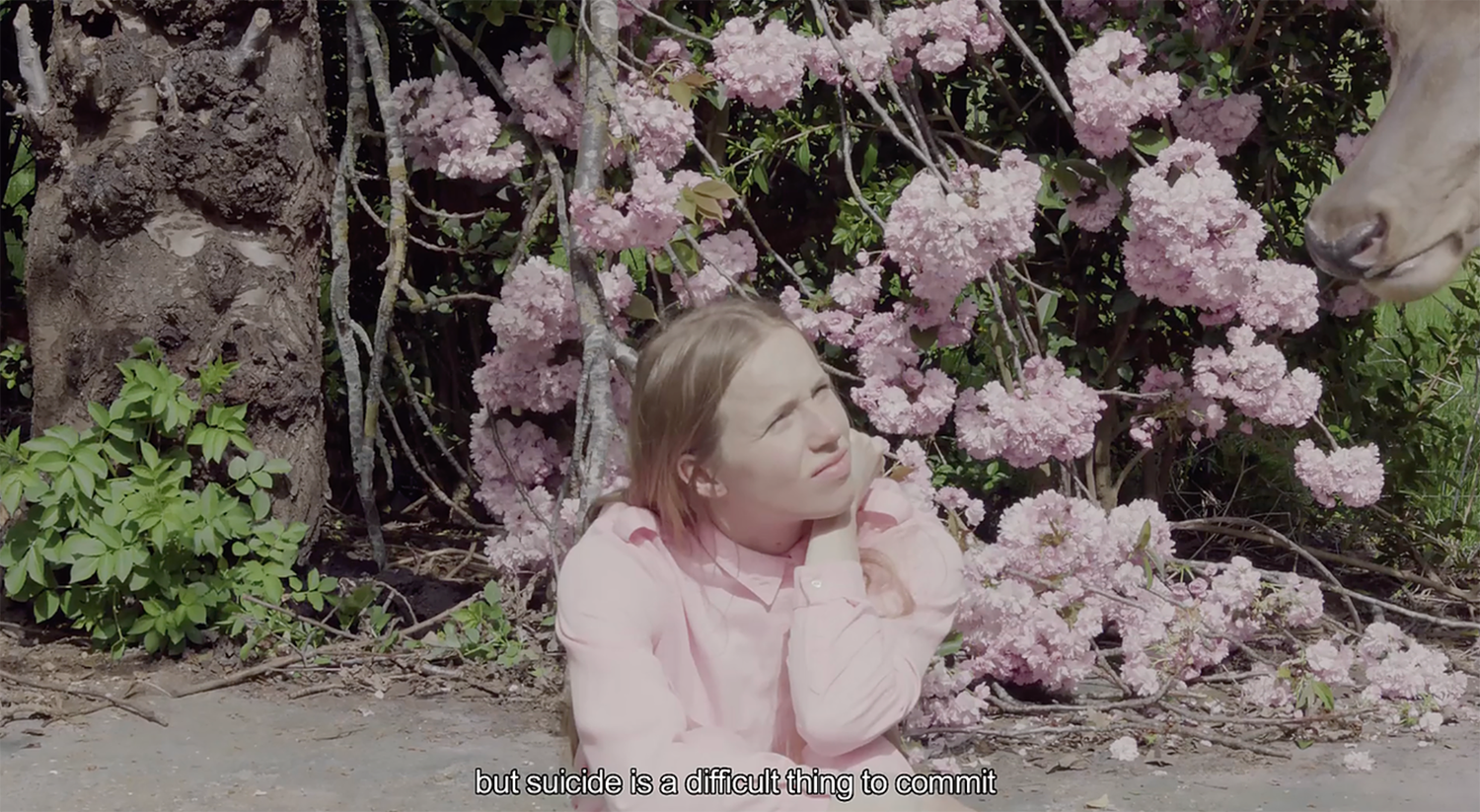Hope There's Someone (To Touch)
Clemens von Wedemeyer, Benjamin Verhoeven, Ruth Patir, Hans Op de Beeck, Rachel Monosov, Maria Lucia Cruz Correia

Clemens von Wedemeyer
Getrennter Monolog (Divided Monologue), 2007/2020, digitized slideshow, 80 slides, 11 min
Two people, one turned more to the right, the other more to the left, alternate in the series of slides Getrennter Monolog (Divided Monologue). Their gestures, postures, and orientation create the impression they are related to each other, involved in a communicative, albeit silent exchange. It is, however, not just the soundlessness of the images that creates barriers between them but also the introduction of the language itself into the texts tersely set in white on black. They are self-reflexive sentences that interrupt the series of images and make the relationships between the figures their theme: “He says /, but he doesn’t mean himself but rather me. / It is for Him as an Other difficult to read my thoughts. Indeed, truly understanding me is nearly impossible for Him. / He should not always just look; he should assimilate himself with me as speaker. / We say and think the same thing. / After we have played the game; he should please take responsibility for himself again. / I am someone who has someone else say what he thinks and make others believe what he writes.”
As easily assignable to either of the protagonists, these words force their way between them and direct their relationship to each other spatially. From addressing each other, on the one hand, to withdrawn reflection over one’s own position as a speaker, on the other, these lines of text open up a space that keeps the figures at a distance. The fact that one image follows the other, so that the actors are never seen simultaneously, thus plays into the impossibility of the genuine exchange of which the written sentences speak. Contact is made only indirectly.
For all that, the connections the textual images produce as a link between the actors are all the more dense, as they permeate the distance from the one to the other with pendulum movements that sometimes express the self-contemplation of observing one’s own role, task, or position, sometimes the reflection on the Other, and sometimes the unspoken stage directions for the Other, the expectations or criticism. This enables the text to place the characters in a spatial structure in which they can serve as representatives for a variety of different positions of a speaker as well as for their psychological, social, and aesthetic circumstances. The director, the listener, the critic, the deliverer of the text and its interpreter, the portrayer of Self and of Other, the speaker and the silent one are revealed in the dovetailing of the textual and the visual sequence as roles in the overlapping and intersecting alternation.
…
In the slide projection Divided Monologue the artist explicitly exposes language in this space-generating function. He lends it additional weight, causing it to take on the crucial responsibility of creating and articulating the interstice, while in the earlier works it could still cooperate with the camerawork and the moving action. In watching these images that have been brought to a standstill, the written word finds support for the associative power of its spatialdynamic only in the sequential form of the projected dialogue.
Excerpt from Bringing to a Stand-Still by Beatrice von Bismarck

Benjamin Verhoeven
50.000 SCANS – ACT III & VI, 2018, stop-motion video of scans, 7 min
50.000 Scans focuses on how the choreography of a human body functions in the scanned reality. It explores the physical action of scanning moving images, and holds it against the historical birth of film and the registration of movement through the medium of photography. This video work is made entirely out of scans. Using a self-thought, manual scanning process, Verhoeven generates the shifts between them. Using a flatbed-scanner and a computerscreen, as a newly combined medium, the images are wrapped into one single frame. These scans are then assembled into an animated film.
50.000 Scans is part of an ongoing project called Scanning Cinema that evolves around scanning moving images. The work focuses on how the choreography of the human body relates to its registration technique and how it functions in the scanned reality. It explores this scanned dimension and holds it against the historical birth of film and the registration of movement through the medium of photography. Each Act deals with a different variation on both montage-technique and camera-movement. The sound is adapted to the same scan-process as the images. This version is an edit of the original video (22min 28sec) that consists of 8 acts.

Ruth Patir
Marry, Fuck, Kill, 2019, single channel video, 3D animation, 14 min
Marry, Fuck, Kill is a 3D documentary that reimagines fertility goddesses from ancient times as real life women. In the film, the artist filmed herself and her mother using a motion capture suit. She then used the recorded movements to animate ancient female figurines from the time of the Israelites first temple (528 BC). Patir placed the figurines in a local Israeli landscape, which increases the sense of dissonance between the past and the present, the static and the moving, oppression and freedom.

Hans Op de Beeck
Staging Silence 3, 2019, HD video, black and white, sound, 45 min
Two pairs of anonymous hands construct and deconstruct fictional interiors and landscapes on a mini film set of just three square meters in size. The viewer goes on a visual journey through depopulated, enigmatic and often melancholic, but nonetheless playful, small-scaled places, which are built up and taken down before the eye of the camera. The two pairs of anonymous hands, like a double Deus ex Machina of sorts, decide on the life and death, growth and blossoming or decay of the places that are conjured up. The landscapes and interiors are teaming with cultural and subcultural references, including historical as well as current themes that refer to the way in which man – both in his dealings with architecture and with nature — ‘humanises’ the open space in an attempt to create meaning, identity and a logical interaction with time. Op de Beeck’s film is accompanied by a score inspired by the images, composed and performed by composer-musician Scanner (uk).

Rachel Monosov
Melodica, 2017, HD video single-channel, color, 27 min
Three young actors, two woman and a man, spend their days in the meditative, sun-filled, sprawling spaces of House Van Wassenhove, a concrete modernist architectural delight melted into the green environment that surrounds it, and set in the middle of Sint-Martens-Latem, one of the wealthiest municipalities of Belgium. The three young people have the air of luxurious, laid-back living. They fill their days with painting, playing piano, and eating clams, living in a kind of art enclave detached from the real world.
This concealed, peaceful location can be read as a Garden of Eden. It feels as if we walk around in The Golden Age by Lucas Cranach the Elder, the painting that structures the film. As a whole, the setting is a separation from the general state of the world; an escape out of the accelerated Anthropocene; an antidote to the turbulent storm of world disorder; a fertile ground for artistic inspiration and introspection; a fitting place to contemplate our contradictory, toxic age of political conflicts, wealth inequality, and environmental degradation; to search for spiritual and religious significance. But, herein is the paradox: the three inhabitants protect themselves from any danger. But, is the danger not enclosed in this absence of danger? How can they contemplate about a world in which they do not participate? Is this idealized world as ideal as it looks? Is this triumph of love and art over war and misery, not straight up delusional?
Excerpt from catalogue essay by Sofie Crabbé, art critic and curator
Hope There’s Someone (To Touch)
MAY 15 – JUNE 28, 2020
Curated by Catinca Tabacaru & Rachel Monosov
Catinca Tabacaru Gallery presents Hope There’s Someone (To Touch), a video exhibition live now exclusively on our gallery website with works by Clemens von Wedemeyer, Benjamin Verhoeven, Ruth Patir, Hans Op de Beeck, Rachel Monosov, and a live performance ritual by Maria Lucia Cruz Correia. This is Part II of the virtual exhibition trilogy co-curated by Catinca Tabacaru and Rachel Monosov as a response to the current global crisis. Hope There’s Someone (To Touch), picks up where Part I: The Far Away Is Here left off. After an interrogation of the otherness at the heart of the initial response to Covid-19, we find ourselves processing the approximately 8-weeks our global community has collectively spent isolated indoors. This exhibition is our best attempt at reflecting our emotional body during this time.
We now understand what it feels like, but still, not what it is, or when and how it will come to an end.
How do we find solace? How do we offer comfort? Will tomorrow ever come? But today, I miss your touch. I miss the touch of many. Today, time and space can be heard. Within the silence we wonder if fellow humans can explore the inner self best when in isolation. Or, does the reality of aloneness have more in common with the Ego?
Touch, silence, and movement run through the 5 video works in Hope There’s Someone (To Touch), like the fil rouge of our current global experience… sometimes it feels like experiment might be the term more fitting.
Divided Dialogue, Clemens von Wedemeyer’s 80-slides work, premiering digitized here, depicts a conversation between two people caught in one room. The predominant silence, interrupted only by the sound of a projector changing slides, allows the viewer to process the text dialogue, and the expressions in the still portraits of Wedemeyer’s two characters.
We move on to the alluring follow-up of Benjamin Verhoeven’s 50,000 Scans, a work interrogating how the choreography of a human body, as well as sound, function in a scanned reality. Next, Ruth Patir animates the ancient stone rendering of a female goddess in Merry, Fuck, Kill and ends on a philosophical note of the movement from oppression to freedom. We may find ourselves observing the tactile and rhythmic qualities in these works as a prescient reflection on the absence of touch felt during this quarantine time.
We then enter the loop created by Hans Op de Beeck in Staging Silence 3 as two pairs of anonymous hands construct and deconstruct fictional interiors and landscapes on a mini film set. Op de Beeck interprets the cycle of human intervention on Earth as civilizations are built and destroyed. Are we merely the simulation, even less, the idea being fathomed by some higher all seeing eye? This question is considered by Rachel Monosov in Melodica, a film in which the artist creates a beautifully detached world inside the sprawling spaces of House Van Wasserhove, a concrete modernist architectural delight melted into the green environment that surrounds it. In both Op de Beeck’s and Monosov’s films, a melancholic sensations – composed through hyper aesthetics, detachment from the real world, and meditative rhythms – builds towards existential questions in search of meaning.
Much like the characters in these five video works, we have been presented with a new reality. Time and space have been challenged, giving us an entry point to the unknown – in equal parts terrifying and sublime. Perhaps the nature of our relationships and conversations has changed? Perhaps we have made space for a parallel virtual reality on which we are now dependent; or maybe we’ve re-ordered our priorities and our work/life balance?
As we prepare for the inevitable exodus, one of the questions we find ourselves asking is what long term effects will this time have on our social and psychological behaviors?
Maria Lucia Cruz Correia proposes one path into the near future as she addressed nature colonization and the present climate emergency. On the next full moon, Friday, June 5 at 9pm CET (4pm EST), Correia invites us to join her on Zoom for a performative ritual to become a Guardian of Nature, i.e. a human able to act as representative to a nature entity, like a river or a mountain, which is granted personhood in a court of law. (RSVP to lowery@catincatabacaru.com)
For us, Part II of this online trilogy reflects the very core of our curatorial concept. It is our way of staying in relationship with, and within, the community we have built around the world over the past six years. There is nothing we want more than to see all of you IRL, and we hope very much this day will come soon.
JUNE 21, 2020
Maria Lucia Cruz Correia: Guardian of Nature
Performative Ritual via Zoom
During the summer solstice, Sunday. June 21st, Maria Lucia Cruz Correia invited us to join her on Zoom for a performative ritual to become a Guardian of Nature, i.e. a human able to act as representative to a nature entity, like a river or a mountain, which is granted personhood in a court of law. This falls within Correia’s practice of offering utopian public services as alternatives for the current capitalistic system.
Through the use of performative rituals and animistic dialogues we must go beyond the “imagined disaffection.” We need to understand the sublimity of nature and search for the quality of greatness beyond human eye. Maria Lucia Cruz Correia proposes a contract with nature and considers its central challenge: What language do things of the world speak that might allow humans to reach an understanding with them, contractually?
May 28, 2020
In conversation with Sanja Latinovic
Hosted by Catinca Tabacaru
May 21, 2020
Artist Talk with Anne Duk Hee Jordan
Co-hosted by Catinca Tabacaru and Rachel Monosov
MAY 15, 2020
TRAILER: Hope There’s Someone (To Touch)
Created by Benjamin Verhoeven
MAY 9, 2020
Silence, Conversation, and Movement
A discussion springboarding from Marie Jose Burki’s A film.
On May May 9th, co-curators Rachel Monosov and Catinca Tabacaru invited Sarah Zürcher (curator, writer, documentary filmmaker), Emiliano Battista (philosopher), and Caroline Daish (actress and voice performer) to join artist Marie José Burki, whose work A Film, is the final installment of The Far Away Is Here, to speak with us about life, film, and curating.
Sarah Zürcher is currently an editor, art writer, freelance curator and documentarian. Since the 1990’s, she has organised exhibitions and festivals in London, Cairo, Delhi, São Paulo, Paris, Marseille, Tallinn and has lectured in Latin America, Africa, the Middle East and Europe (Slovakia, Belgium, United Kingdom, Lebanon, France and Switzerland)
She served as Director of Museum Langmatt, Baden, Switzerland (2014–2016), Director of the Art School esba TALM, Tours, France (2009–2013) and Director of Fri-Art, the contemporary art centre in Fribourg, Switzerland (2002–2007). She has also worked at the Kunsthalle Bern, Switzerland; MAMCO (Musée d’art moderne et contemporain), Geneva and Cabinet des estampes (Print Room), Geneva. For the cities of Baden and Zurich, she participated in the creation of a number of projects in public spaces, including Infolge: Kunstprojekt Bahnhof Baden (2000).
Zürcher has regularly published articles and essays on contemporary art, and she has edited catalogues for Sharjah Art Foundation and previously for the Biennial of the Image in Movement, among others. She is also a member of the International Association of Art Critics (AICA) and International Council of Museums (ICOM).
Emiliano Battista is a translator (mostly but not exclusively of French philosophy and theory), a researcher when time permits (on those occasions he works on a project about the place and function of the book in the world of contemporary art), and a Sunday author and lecturer.
He has worked on books with Aglaia Konrad, Mitja Tušek, Herman Asselberghs, and Sophie Whettnall; he conceived and produced Daan van Golden Photo Book(s) (Koenig 2014), which is something of a study of repetition. In partnership with theTomorrow, he conceived and animated a program of discussions and screenings at the 56th Venice Biennale (2015), whose participants included Alexander Kluge, John Akomfrah, Maurizio Lazzarato and Jacques Rancière.
Caroline Daish is intrigued by the way we listen and what happens to the sense of self when our listening is displaced. In 2016 she received a Vlaamse Overheid grant to study ‘spatial sound and empathy’, her research created a trilogy of live binaural performances of conversations with her brother about his psychosis and artistic practice. Her early career began as co-director and choreographer for Australia’s leading disability youth company, Restless Dance. With collaborators, Michel Yang and Justine Maxelon she developed a body voice practice ‘oracle’: an eyes-closed body-voice improvisation practice that reads diverse spaces: train stations, parks, institutions, forests, public libraries, urban gardens and private living spaces.
During the COVID-19 lockdown she and her colleagues has been conducting telepathic oracle practices with artists in different countries. She has a long time collaboration with Australian film director and composer Jason Sweeney. In 2014 she was awarded Best Actress from Melbourne Underground Film Festival for the leading role in Sweeney’s feature film “The Dead Speak Back”. Caroline has a Bachelor in Education (BA) and a Graduate Diploma of Arts Management and has completed post-graduate studies in performance research with a.pass and documentary film with SoundImageCulture.
APRIL 16, 2020
TRAILER: The Far Away Is Here
Created by Axel Korban, Commissioned by Rachel Monosov and Catinca Tabacaru